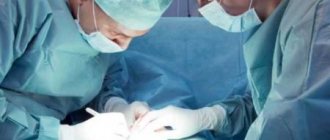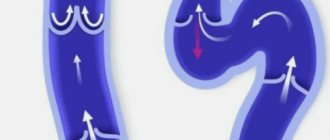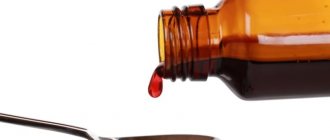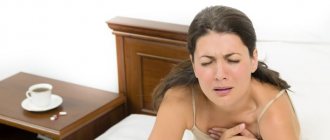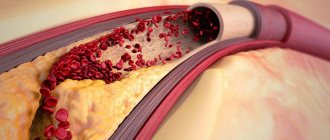Varicocele is a pathological enlargement of the scrotum, with dilated grape-shaped veins visible through the skin. According to statistics, the disease is observed in more than 15% of the male half of the world's population. Approximately 1/3 of all cases occur during reproductive age. Mostly pathological processes develop on the left side - in 98% of all cases. Rarely, the disease is bilateral. If varicocele is ignored, the consequences may become undesirable.
Varicose veins on the testicles are life-threatening. In the initial stages it may occur without obvious symptoms. For this reason, men can live with this diagnosis for many years. Possible complications pose a threat if the disease is not treated.
Who gets varicocele?
According to statistics, every sixth to seventh man under the age of 25 suffers from varicocele, but children's varicocele - from 13 to 17 years old - is more common. The disease manifests itself in adolescents during puberty. Until this time, any symptoms of varicocele practically do not bother the patient and therefore diagnosing the disease at this age is quite difficult.
Quite often the disease occurs in adult professional athletes whose activities involve high physical activity. Due to the weakening of the body, varicocele can also appear in adulthood in men over 50 years of age.
Signs of the disease, if present, may often not appear, and are often discovered only when visiting a urologist for some other reason or during an examination for male infertility.
In more than 80% of cases, the disease develops only on the left side - left-sided varicocele, right-sided or bilateral is much less common.
When is surgery indicated?
Diagnosis and prescription of surgery should be carried out only by a specialist urologist or andrologist. In this case, the doctor takes into account the degree of pathology and the patient’s age. Today, the microsurgical method varicocelectomy is often used.
Indications for surgical procedures include:
- Pain, discomfort in the groin. The presence of even mild pain indicates inflammation and microthrombi;
- Inability to conceive with impaired spermatogenesis. In this case, varicose veins of the spermatic cord are present;
- Prevention of infertility. Experts differ on this issue;
- Cosmetic defect. Stimulates the sick person's complexes.
Surgery may also be prescribed for grade 2 varicocele. The reason for this event is infertility and severe pain.
It is noted that the use of shapewear, regulation of physical activity, and drug treatment cannot completely cure the pathology. Deterioration of spermogram results in the absence of other symptoms of the disease requires regular visits to the doctor for prevention.
Cause of the disease
The main mechanism for the occurrence of varicocele is the same as for the appearance of varicose veins on the legs - unstable operation of the venous valves in the vessels, as a result of which the reverse outflow of blood occurs and pathology of the venous network occurs.
The situation is often complicated by the fact that metabolic products that are carried in the blood and should be excreted in the urine remain near the testicle, poisoning the surrounding cells.
Another, less common reason is the appearance of a blood clot (for example, in the inferior vena cava) or the presence of a tumor compressing a large vein (for example, one of the renal veins) in the patient’s abdominal cavity.
What are the reasons that contribute to the appearance of varicocele?
- Most often, these are individual anatomical, usually congenital, pathological changes that are expressed in thin vessel walls and weak venous valves.
- Diseases, bruises, injuries in the lumbar spine, pinching normal blood flow.
- Excess weight.
- Circulatory disorders in the pelvic area as a result of prolonged standing on your feet, prolonged sitting, too frequent or, on the contrary, irregular sex, prolonged and frequent erection without orgasm, regular masturbation, frequent and chronic constipation.
- Psychosomatic problems - lack of confidence in one’s sexual abilities, prolonged sexual lust, feelings of guilt as a result of unsuccessful sexual intercourse.
- Overheating of the testicles (in a sauna, steam bath, while taking a hot bath).
- Wearing too tight and tight underwear and clothing.
In addition to the frequent question of how varicocele is treated, patients are also interested in whether varicocele goes away on its own? No. Varicocele does not go away on its own. Modern medicine treats the disease only with surgery.
Characteristic features of the disease
Varicose veins in the testicles are classified according to the location of the lesion. Left-sided varicocele is observed more often than dilation of the testicular veins on the right. Bilateral varicose veins may also be observed.
Many men believe that with a unilateral lesion, the functions of the second testicle are not impaired, but this is a common misconception. Spermatogenesis of the other testicle is also reduced, but not to such a significant extent as in the affected organ.
An isolated testicular varicocele on the right indicates tumor processes in the kidneys and possible retroperitoneal fibrosis . A varicocele on the left may spread to the right side of the scrotum. The vein on the left is longer.
When stretched, part of the vein begins to shift to the right. This provokes mechanical pressure on the right vein, which can lead to disruption of blood flow and the development of testicular varicocele on the right side inclusive. Then bilateral testicular damage is diagnosed. Fortunately, such cases are rare.
Varicocele can be primary (idiopathic), in which the hereditary structure of the veins is the cause of the disease. As a rule, varicocele on the right is secondary (symptomatic). In this case, the provoking factor will be an external cause (mechanical pressure due to various diseases).
Symptoms of varicocele
How does varicocele manifest? What symptoms can be used to determine the onset of the disease?
- Discomfortable sensations in the scrotum;
- nagging pain in the testicular area, which occurs or intensifies when a person stands, sits, during increased physical activity, during an erection, during defecation;
- visual reduction of one testicle compared to the other;
- an increase in the temperature of one or both testicles, determined tactilely.
The presence of one or several of these factors at the same time is a serious reason to visit a urologist for examination, who will tell you how varicocele is treated in a particular case.
Disease prevention
By following certain preventive measures, you can minimize the risk of development and recurrence of varicocele: eat right, eat foods that have a beneficial effect on the intestines, take vitamins; avoid heavy physical activity; Use protection measures during sexual intercourse.
Since the disease is often hereditary, you should undergo regular examinations by doctors, starting from adolescence. With timely detection and diagnosis, it will be possible to cure varicocele without surgery.
Methods for diagnosing varicocele
Since often the symptoms of testicular varicocele do not appear externally, the presence of the disease can only be detected by chance, when visiting a doctor for another reason, or when complications arise. It is for this reason that urologists recommend regular medical examinations.
How exactly is varicocele diagnosed?
- Carrying out an external examination when there are obvious symptoms of the disease;
- undergoing an ultrasound;
- performing a spermogram.
The course of the disease is divided into four stages, depending on the method of diagnosis:
- Varicocele can only be detected using ultrasound or Doppler ultrasonography (Doppler ultrasound) - the so-called subclinical varicocele.
- Swollen veins can be felt while the patient is on his feet.
- The veins can be felt while the patient is lying down.
- Dilated veins are visible upon visual inspection.
The most common question: is it necessary to undergo surgery if a varicocele is detected if the disease is asymptomatic and does not cause discomfort to the patient? In European clinics the answer is clear – surgery.
Russian medicine in this situation takes a wait-and-see attitude, with the condition that the patient will be observed by a doctor, undergo regular examinations, have a spermogram, and know how varicocele is treated in order to prevent complications.
Despite the fact that, in addition to the development of disorders in the male genital area, the disease is the first warning of the imminent appearance of varicose veins in the legs and/or the appearance of hemorrhoids, the detection of varicocele in a man does not at all mean the need for immediate surgery.
How do doctors detect the disease?
When diagnosing varicocele, there are four degrees of the disease:
- First: an insignificant level of venous expansion, which cannot be detected visually due to the absence of convex veins. A diagnosis can only be made using an ultrasound of the scrotum, Dopplerography of the venous vessels and a spermogram, which helps determine signs of infertility.
- Second: the affected veins can only be felt in a standing position. There are no external manifestations, but a feeling of heaviness may appear during physical activity.
- Third: by palpation, the doctor can easily determine the lesion of the veins in any position of the patient’s body. In a vertical position, the veins descend to the bottom of the scrotum and slightly deform it. The testicle becomes swollen and atrophic. Pain syndrome is clearly manifested, which leads to reduced ability to work.
- Fourth: a decrease in testicular size becomes the most noticeable symptom.
For diagnosis, urologists use the following methods:
- Ultrasound (lying and standing): it is prescribed for a minor degree of development of the disease in order to better examine the vessels.
- Palpation: in an upright position of the body, the doctor palpates the venous plexus.
- Valsalva maneuver: when the abdominal muscles are tense, the doctor palpates the enlarged veins.
- Spermogram: one of the methods that is used to determine infertility with varicocele.
How varicocele is treated in clinics
Treatment of varicocele with tablets, traditional medicine recipes and other conservative methods for varicocele is not effective, will not bring the expected results and is used only to alleviate the symptoms of the disease.
As a rule, surgery for varicocele is performed only in cases of pain in the testicular area and/or complaints of infertility. Most experts, however, are of the opinion that in adolescents, surgery for varicocele in order to prevent infertility must be carried out as planned.
Currently, four types of operations for varicocele are used:
- Classic open surgery according to Ivanisevich/Palomo.
- Endovascular sclerotherapy.
- Surgery using laparoscopic method.
- Microsurgical revascularization according to Marmar.
Free varicocele surgery can be performed routinely in a regular hospital. It is not difficult; with timely intervention and the absence of complications, the patient can be sent home after 2-3 days.
Although many patients prefer to go to paid clinics, where the care is much better and they employ high-level professionals. The cost of a paid Marmara operation in Moscow clinics varies from 20 to 90 thousand rubles.
Treatment
Complex therapy is determined through a thorough examination. In this case, the diagnosis carried out in a lying position is then duplicated while standing. Such measures allow us to achieve more objective results.
If pathological processes are accompanied by pain in the scrotum, as well as infertility, then surgical intervention is required immediately. If no symptoms cause discomfort to a man, then surgery can be avoided.
In the treatment of varicocele, 3 main treatment methods are used:
- The traditional method is surgical intervention according to Ivanissevich. The dilated vein is ligated, crossed or removed. To perform this method, 3-5 centimeter incisions are made;
- Endoscopy. In this case, 3 small punctures are made in the patient's abdomen. Then specialists insert an endoscope and ligate the affected testicular vein. The time required for the operation is approximately 15-20 minutes;
- Stopping the movement of blood through a vessel by sclerosing the veins of the spermatic cord. A vein is punctured and a catheter is inserted. The device penetrates first into the inferior vein, then into the renal vein and the mouth of the dilated vein. After this, it is filled with a special substance that blocks the blood flow.
Possible complications after varicocele
Possible risks and complications of varicocele are divided into three categories:
- During the operation, as a reaction to the use of anesthetics: hypoxia - acute lack of oxygen, artymia - heartbeat disturbance, sharp decrease in blood pressure.
- During the operation, as a reaction of the body or as a result of a surgical error: the opening of bleeding, erroneous ligation of the artery (during the Ivanisevich/Palomo operation), accidental nerve damage (you need to understand that most operations are performed through a mini-access, limiting the surgeon’s capabilities), an allergic reaction to injected active substance (for sclerosis of the vein).
- In the postoperative period: severe swelling, testicular atrophy - reduction in size, the appearance of hydrocele (hydrocele) of the testicle - tumors as a result of accumulated fluid, recurrence of varicocele.
Non-surgical therapy for testicular varicocele
Based on the diagnostic results, the phlebologist determines how to cure varicocele. In case of secondary varicose veins, the underlying disease is treated. Conservative therapy is aimed at restoring blood circulation in the pelvic organs. Men of reproductive age are prescribed:
- venotonics (Venovital, Proven phytoconcentrate) – increase the elasticity of the walls of affected vessels;
- vitamin and mineral complexes (Vitakap, Vitrum) - restore metabolism, have a general strengthening and tonic effect on blood vessels;
- probiotics (Enterol, Maxilac) – normalize intestinal microflora, prevent constipation and increased pressure in the pelvic organs;
- non-narcotic analgesics (Indomethacin, Piroxicam) – relieve groin pain and inflammation;
- antibiotics (Loflox, Zanocin) - destroy bacterial infection in varicocele caused by pyelonephritis.
To improve blood circulation in the testicles, it is recommended to wear a suspensor - a supporting elastic bandage for the scrotal organs.
What are the dangers of varicocele in advanced cases?
It is not enough to know how varicocele is treated; you need to be fully aware of the consequences that advanced cases of the disease can lead to.
In 50% of cases, this is, first of all, infertility - a blow to the pride of any man, problems with erection, up to the complete impossibility of sexual intercourse. Further, mental problems arise - imbalance, low self-esteem, problems in sexual life, and, as a result, a deterioration in the quality of life as a whole.
One of the most popular questions to doctors from teenagers is: do people with varicocele get drafted into the army? According to the list of diseases for which a conscript is subject to exemption from military service, varicocele of 1st and 2nd degrees is not considered an obstacle to conscription for active service. Young men with manifestations of varicocele of degrees 3 and 4 are not subject to conscription.
About infertility
What happens if varicocele is not treated? What does it affect? What is the threat? One way or another, subsequently testicular varicose veins in men negatively affect reproductive function . The loss of the ability to thermoregulate and the increase in scrotal temperature create an unfavorable environment for the functioning of sperm and increases the likelihood of the appearance of defective germ cells.
Important: a common misconception is that if one testicle is affected by varicose veins, the functioning of a healthy testicle is not impaired in any way. This is not so; in the later stages of the disease, pathological processes also affect a healthy organ. He suffers especially greatly from impaired temperature regulation.
If varicocele is not treated, diseases such as orchitis and hydrocele will subsequently occur, which also negatively affect reproductive functions.
The ability to conceive a child is also negatively affected by a general lack of nutrient flow associated with poor circulation with varicose veins.
But varicocele does not always lead to infertility. If a man’s sperm are naturally resistant to negative influences, then oxygen deficiency and overheating of the scrotum will not lead to a complete loss of their ability to fertilize.
Contraindications for varicocele and medical recommendations
What is prohibited for varicocele and what recommendations do doctors give before surgery and during the rehabilitation period?
It is forbidden:
- lift weights and give the body excessively high physical activity;
- overheat the testicles when visiting a bathhouse, sauna or taking a hot bath;
- wear tight underwear;
- drink alcohol and tobacco;
- gain excess weight;
- actively engage in masturbation with varicocele.
Need to:
- eat more vegetables, fruits and other plant products;
- lead an active lifestyle (running, walking, swimming, yoga, gymnastics - in reasonable doses);
- monitor bowel function and, if necessary, take medications that improve gastrointestinal function;
- wear swimming trunks or tight underpants (but not tight ones!) to support the scrotum;
- massage the testicles;
- have regular sex life.
All of these recommendations can also be considered methods for preventing varicocele. Under no circumstances should you self-medicate. Only a specialist knows how varicocele is treated, and if you suddenly suspect manifestations of the disease, you need to go to a medical institution for an examination.
What to do after surgery
After varicocele surgery, it is recommended to refrain from any type of physical activity and emotional stress. During the next 2-3 months after recovery, restrictions on physical work are imposed. Restrictions on sexual activity vary from 20 to 30 days; at the discretion of the doctor, the period can be extended, it depends on the degree of varicocele.
Varicocele after surgery: recovery period. We must not forget about regular examinations with the attending physician. This is the only way to achieve complete restoration of all necessary functions. After varicocele surgery, as a rule, there are no complications, patients feel well, pain disappears. But there are isolated cases when complications arise.
Although improvements after surgery are noticeable, some unpleasant symptoms may still appear. Some patients complain that veins remain after surgery. This can only happen in the unfortunate event that the operation was performed poorly. Then you need to consult a doctor.
There are also complaints such as: after surgery, the varicocele has become enlarged or the testicle, vein and suture are sore, the left testicle is swollen, high temperature, atrophy, dropsy or groin disorder. But these are just isolated cases, which consist in one or another reaction of the body to surgical intervention.
You need to consult a doctor who will prescribe the necessary medications for you and tell you what procedures need to be carried out to get rid of unpleasant sensations. Varicoceles rarely return after surgery, so you can lead a daily life and do your usual activities, but still take certain precautions into account.
After the operation, the patient is able to lead a normal lifestyle. You can return to your normal rhythm of life within a few weeks. Playing sports after varicocele surgery is also possible, you just need to wait a while for the scars to heal and the body to fully recover after the operation.
Varius gel for varicocele
To combat varicocele, as well as support the body during treatment, various medications are used, each of which has its own sphere of influence. A gel for varicocele called Varius turns out to be a fairly effective way to strengthen blood vessels and get rid of many symptoms of the disease. The gel uses components that have a positive effect on the condition of the veins. Carefully selected dosage increases the effectiveness of the medicine.
Varius for Varicocele: what effect does it have?
This remedy is often prescribed by specialists, as it has all the necessary types of effects. These include:
- Relieving pain, as well as feelings of discomfort that sometimes arise after physical activity, changing position, walking and other factors;
- Provides natural return of blood flow that comes from the veins of the testicles;
- The gel creates correct suppression of the convulsive state;
- Venous walls are less susceptible to stretching and their strength increases;
- Blood congestion is relieved, which often leads to exacerbations of the disease, and can also cause various complications.
This set of effects helps eliminate the symptoms and causes of the disease at the first stage, almost after the first course of administration. If the desired effect cannot be achieved, it is recommended to repeat the course or perform surgery.
Varius gel for varicocele: composition
The composition contains natural agents that create a venotonic effect and relieve swelling. The main components include:
- Ginkgo biloba. A product for giving veins a good healthy tone and eliminating blood stagnation. This is an exotic plant that is actively used in medicine and has found application in this gel.
- Bee venom. This thick substance contains a huge range of useful substances with a high degree of biological activity. It relieves swelling and makes blood vessel tissue more elastic.
- Antlers (concentrate). A unique medicinal product that is extracted from the antlers of deer living in Altai. It promotes faster recovery and tones the veins.
Varicocele cream: how to use
This remedy can be used both for the treatment and prevention of the disease. It is enough to lubricate Varius once a day on the problem area. It is advisable to do this in the evening before going to bed so that it does not become smeared from walking and other movements. It can be used either alone or in combination with other drugs. For a more serious stage of the disease, it is recommended to apply the gel twice a day.
Varius: reviews, varicocele
Various comments can be found from patients who have used this remedy for the treatment and prevention of varicocele. Most write that the medicine really helps, especially in the early stages. Some patients still have to undergo surgery, which helps with greater efficiency.



